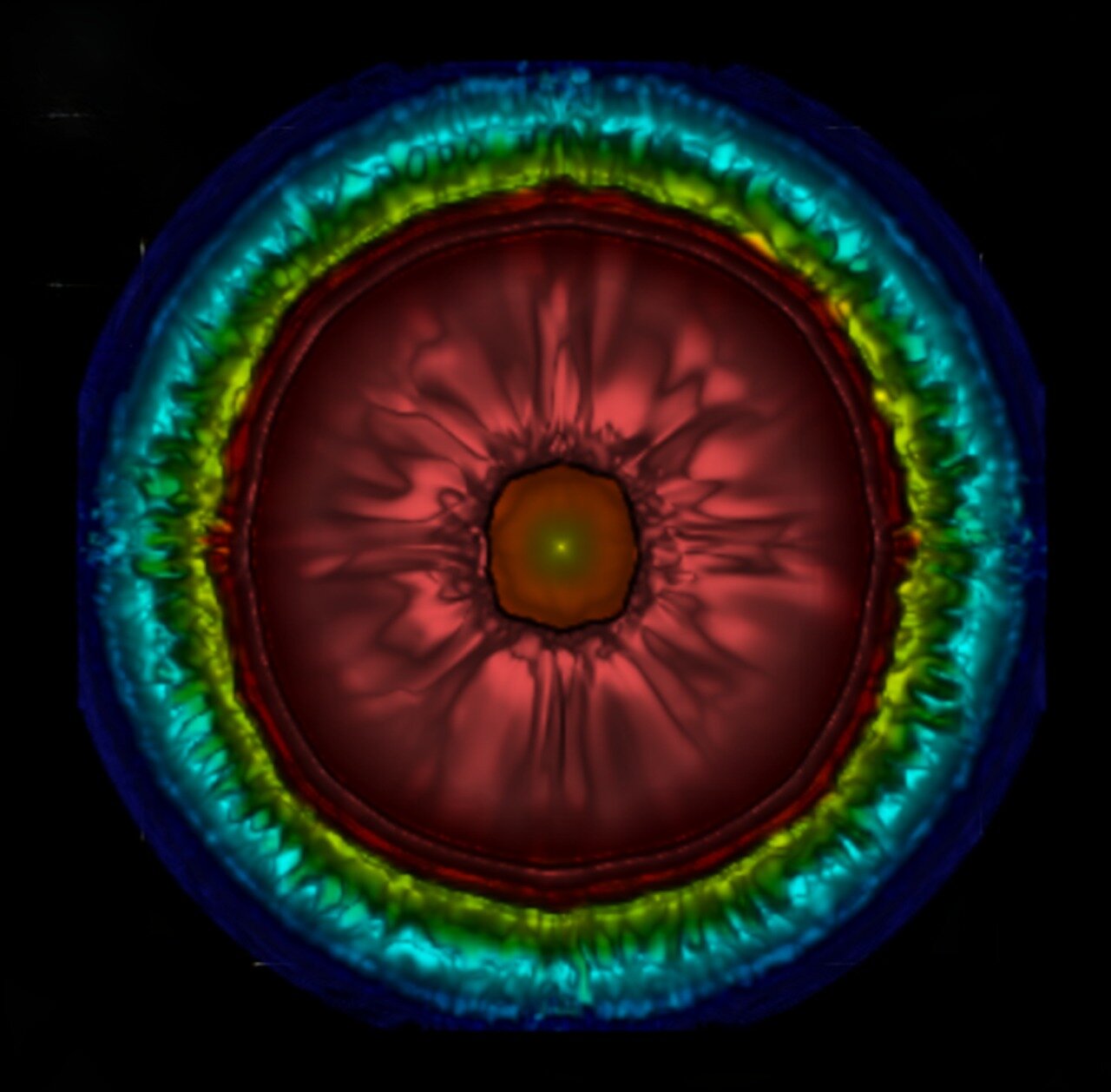
After years of dedicated research and over 5 million supercomputer computing hours, a team has created the world’s first high-resolution 3D radiation hydrodynamics simulations for exotic supernovae. This work is reported in The Astrophysical Journal.
Ke-Jung Chen at Academia Sinica Institute of Astronomy and Astrophysics (ASIAA) in Taiwan, led an international team and used the powerful supercomputers from the Lawrence Berkeley National Laboratory and the National Astronomical Observatory of Japan to make the breakthrough.
Supernova explosions are the most spectacular endings for massive stars, as they conclude their life cycles in a self-destructive manner, instantaneously releasing brightness equivalent to billions of suns, illuminating the entire universe.
During this explosion, heavy elements formed within the star are also ejected, laying the foundation for the birth of new stars and planets and playing a crucial role in the origin of life.
Supernovae are a key interest in modern astrophysics, encompassing numerous important astronomical and physical issues in both theory and observation, holding significant research value.
Over the past half-century, research has provided a relatively comprehensive understanding of supernovae. However, the latest large-scale supernova survey observations are revealing many unusual stellar explosions (exotic supernovae) that challenge and overturn previously established understanding of supernova physics.
Among exotic supernovae, superluminous supernovae and eternally luminous supernovae are the most perplexing. The brightness of superluminous supernovae is about 100 times that of regular supernovae, which typically only maintain their brightness from a few weeks to a few months.
In contrast, eternally luminous supernovae can maintain their brightness for several years or even longer. Even more astonishing, a few exotic supernovae exhibit irregular and intermittent variations in brightness, resembling fountain-like eruptions. These peculiar supernovae may hold the key to understanding the evolution of the most massive stars in the universe.
The origins of these exotic supernovae are still not fully understood, but astronomers believe they may arise from unusual massive stars. For stars with masses ranging from 80 to 140 times that of the sun, as they approach the end of their lives, their cores undergo carbon fusion reactions.
During this process, high-energy photons can create electron-positron pairs, triggering pulsations in the core and leading to several violent contractions. These contractions release vast amounts of fusion energy and trigger explosions, resulting in great eruptions in the stars. These eruptions themselves can be similar to regular supernova explosions. Moreover, when materials from different eruption periods collide, it is possible to produce phenomena similar to superluminous supernovae.
Currently, the number of such massive stars in the universe is relatively rare, which aligns with the scarcity of peculiar supernovae. Therefore, scientists suspect that stars with masses ranging from 80 to 140 times that of the sun are highly likely to be the progenitors of peculiar supernovae. However, the unstable evolutionary structures of these stars make their modeling quite challenging, and current models mainly remain confined to one-dimensional simulations.
However, serious deficiencies were found in the previous one-dimensional models. Supernova explosions generate significant turbulence, and turbulence plays a crucial role in the explosion and brightness of supernovae. Nevertheless, one-dimensional models are unable to simulate the turbulence from the first principles. These challenges have inhibited a deep understanding of the physical mechanisms behind exotic supernovae in current theoretical astrophysics.
This high-resolution simulation of supernova explosions presented immense challenges. As the scale of the simulation increased, maintaining high resolution became increasingly difficult, significantly raising the complexity and computational demands, while also requiring the consideration of numerous physical processes.
Ke-Jung Chen emphasized that their team’s simulation code had advantages over other competing groups in Europe and America. Previous relevant simulations were mainly limited to one-dimensional and a few two-dimensional fluid models, whereas in exotic supernovae, multidimensional effects and radiation play a crucial role, influencing the light emissions and overall dynamics of the explosion.
Radiation hydrodynamics simulations consider radiation propagation and its interactions with matter. This intricate process of radiation transport makes the calculations exceptionally challenging, with computational requirements and difficulties much higher than fluid simulations.
However, due to the team’s rich experience in modeling supernova explosions and running large-scale simulations; they have finally succeeded in creating the world’s first three-dimensional radiation hydrodynamics simulations of exotic supernovae.
The research team’s findings indicate that the phenomenon of intermittent eruptions in massive stars can exhibit characteristics similar to multiple dimmer supernovae. When materials from different eruption periods collide, approximately 20–30% of the gas kinetic energy can be converted into radiation, which explains the phenomenon of superluminous supernovae.
Furthermore, the radiation cooling effect causes the erupted gas to form a dense but uneven three-dimensional sheet structure, and this layer of the sheet becomes the primary source of light emission in the supernova. Their simulation results effectively explain the observational features of the exotic supernovae mentioned above.
Through the cutting-edge supercomputer simulations, this study makes significant strides in gaining insights into the physics of exotic supernovae. With the commencement of next-generation supernova survey projects, astronomers will detect more exotic supernovae, further shaping our understanding of the final stages of usual massive stars and their explosion mechanisms. https://phys.org/news/2023-09-world-3d-simulations-reveal-physics.html








Recent Comments